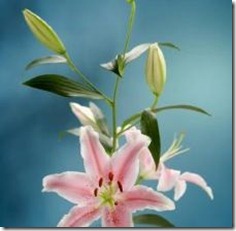Garden lilies epitomize the most elegant characteristics of the large plant family Liliaceae. The group is one of the largest and most diverse families of flowers. Even among the genus subgroup lilium, there are flowers that bear little resemblance to their garden-dwelling cousins. Other genuses within the family Liliceae share characteristics that make them like the garden lilies that bloom throughout the summer.
Lilium Species
-
Species lilies are ancestors of garden hybrids.
Lilies are herbaceous perennials that grow from a "true bulb," a specialized fleshy root that stores nutrients during one season for growth during the next. Lily bulbs grow in a bouquet of bulbils, like garlic, that can peel off to form new plants. Six tepals — three sepals and three petals — surround carpels and stamens in lily flowers. Garden hybrid lilies descend from dozens of native species in Asia, Europe and North America. Native groups include Martagons, Pseudolirium, Liriotypus, Archelirions, Sinomartagons, Leucolirions and Daurolirions. Many bloom in recurved Turk’s cap, upturned or hanging bell shapes.
Lilium Bulbs
-
 This six-tepaled tulip is a member of the lily family.
This six-tepaled tulip is a member of the lily family.Members of the lilium family survive during droughts and climate changes thanks to their specialized roots. The scaled bulb not only stores food but can break into dozens of duplicates of the parent. The second type, the tunicate bulb, covered by a protective "tunic" of tissue, reproduces by offsetting bulblets. Fritillaria and tulips are spring-blooming tunicate bulbs. Erythronium, or dog-tooth lily, is a woodland native of North America and Asia. China’s alpine lily, Nomocharis, grows from scaled bulbs and blooms mid-summer. Lloydia, another alpine bulb, grows from northern Europe to Asia; the UK native is known as the Snowdon Lily.
Lilylike Flowers
-
 Daylilies are often mistaken for lilies.
Daylilies are often mistaken for lilies.Plants with flowers resembling lilies that do not belong to the lilium group may grow from tubers or rhizomes. Hemerocallis, or daylilies, flower in trumpets similar to Asiatic lilies. They also bloom in double or spider forms that feature multiples of three tepals in groups atop stems called scapes. Daylily roots may include tubers; crowns clump to grow mounds of grassy leaves. The surprise lily, Lycoris squamigera, blooms in mid- to late summer above leaves that wither before the flower blooms. Pink and lavender "magic" lilies are members of the amaryllis family. Brilliantly detailed amaryllis, or Hippeastrum, has six tepals and multiple blooms atop one stalk.
In Name Only
-
 Peruvian lilies are not lilies at all.
Peruvian lilies are not lilies at all.Red Spider lily, lycoris radiata, another amaryllis family member, blooms in bursts of pink to red feathery blooms in late summer. White spider lily, hymenocallis latifolia, is a less-downy-flowered tropical bulb. Both bloom after heavy late-summer rains, earning them the name "hurricane lilies" in the South. Fairy or rain lily, Zephyranthes, is another amaryllis relative that resembles an open-faced crocus. Nymphaea species, or water lilies, have neither bulb nor three-petaled flower form; they are submergent water plants that grow from rhizomes and bloom in many-petaled white to pink flowers that float on the water’s surface. Alstroemeria, Peruvian lilies, bloom in late spring or early summer. Flowers frequently contain two showy marked tepals that make them look like orchids.


Deprecated: strpos(): Passing null to parameter #1 ($haystack) of type string is deprecated in /home/agriviek8Qv/agriviet.net/public_html/wp-includes/comment-template.php on line 2522